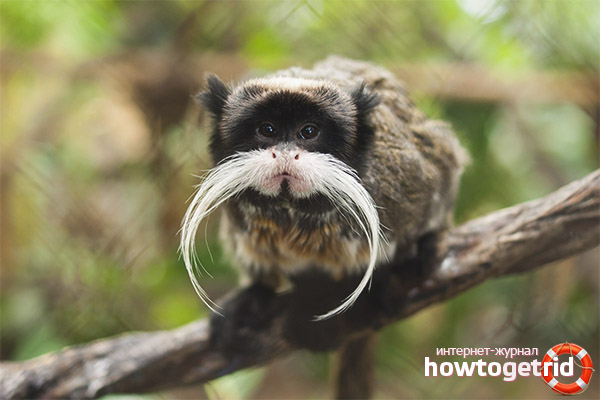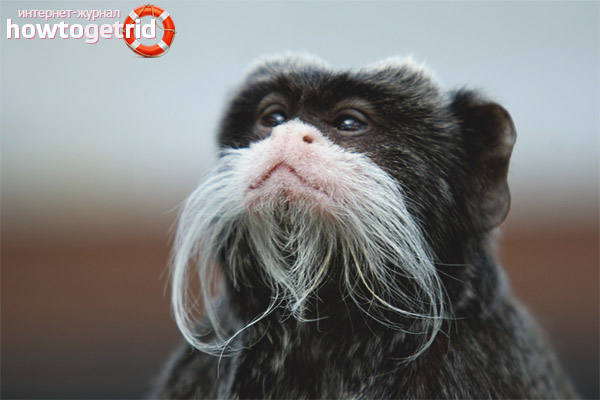The content of the article
In the world there are many species of monkeys. They differ in appearance, size, behavior. Monkeys live in many parts of the world. One of the very interesting and original monkeys is the imperial tamarines. These are very small monkeys that belong to the marmoset family. They have one interesting feature, due to which they can be easily distinguished from other species.
But these cute monkeys differ not only in their appearance. In other species, the leader of the flock is the male, but for imperial tamarins the situation is different. The flock is headed by the oldest female. They have representatives of different sexes as if partially exchanged roles. After all, in their flock, males should get food, as well as carry cubs with them. This species was discovered in 1907. Let us consider in more detail why these monkeys have such a name? What are their distinguishing features? Where do they live? What do they eat?
Appearance
Their color is dark, almost black. But the beard and mustache contrast with the general coloring of the fur of monkeys. These parts are completely white, they look like gray. It is this feature that is most attractive in them, and thanks to it they are noticeably different from others.
Part of the name "imperial" animals received precisely because of their chic mustache. When scientists discovered this species, they immediately remembered that one of the German emperors by the name of William II had exactly the same mustache. Such a name at that time seemed to the researchers the most suitable. That it was fixed to the view.
Habitat
This species of primates lives in the tropical forest of South America. They can be seen in countries such as Peru, Bolivia, as well as in Brazil.
Nutrition, lifestyle
These monkeys are arboreal animals. That is, they spend most of the time on trees. For this, their body is perfectly adapted. They have a long tail, which performs the function of balancing, powerful claws that help to cling to the bark of trees, and nimble paws that hold the monkeys on the tree. Since they are very light, they can easily climb even to the top of the tree, where they get the most juicy fruits.
As a rule, they are found only in a dense forest. They bypass any open space. They live in small groups of up to 10 individuals. Each flock has its own specific territory, which tamarins zealously protect from the encroachment of enemies. If suddenly other similar monkeys want to settle in their place, then the owners of the territory will not allow them. The territory occupied by one group of tamarins is usually about 30-40 ha. They protect their territory not with their powerful claws and fangs. They also attack those who dare to offend their babies.
The social hierarchy in packs is well developed.Home here is the most experienced female, followed by all the other females. The next step in the tamarine hierarchy is the kids. Males here occupy the lowest level. In each group, 1-2 males usually live.
Another interesting feature in the behavior and lifestyle of these animals is a regular mustache. They cut their mustache to each other. In the process, animals actively communicate.
The basis of the diet of these primates is plant food. They are very fond of fruits and berries, which are constantly collected from bushes and trees in the rainforest. Their favorite treat is young twigs and leaflets. Sometimes they eat flowers.
Animal food is also present in the diet of these animals. From time to time they catch frogs and lizards. If they come across bird eggs in the nest, they also eat it.
Breeding

During the mating season, the female imperial tamarin may have more than one partner. If the group has not one but several males, it will mate with everyone. Moreover, the order also depends on the position in the hierarchy.
Pregnancy in representatives of this species lasts about 45 days. Since this period is too short even for such small animals, babies are born small, helpless. After birth, they weigh only 35 g.
But even newborn tamarins on the face already have characteristic antennae and beard. Since matriarchy reigns in their lifestyle, males take care of the babies. They constantly carry babies on themselves, and give them to the female only for the duration of feeding.
In the wild, life expectancy is about 11-15 years.
Number
Today, this species is considered “vulnerable”, although the number of tamarins has not yet reached a critical level. Indeed, often these unusual primates become victims of poachers. They are caught to sell in collections or zoos.
The number of representatives of this species, as well as other inhabitants of the rainforest, is affected by the destruction of their natural environment. Indeed, tropical forests on their native continent are being destroyed very intensively. As a result, monkeys simply have nowhere to live and get their own food.
Video: imperial tamarin (Saguinus imperator)











Submit